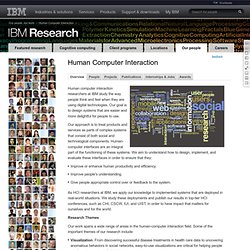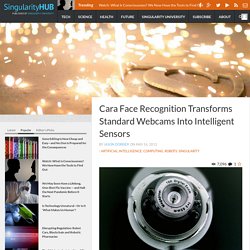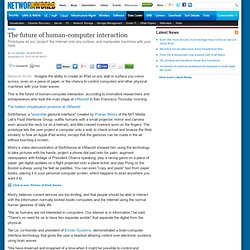

Www.thinkerthing.com. Media Articles misc. Virtual and real worlds near synthesis in internet of things. Big Data Gets Personal. Experts Contacts Events. ++ Techonomy. Changing Perspectives. Best of CHI. CHI 2013. CHI 2013 Papers Video Previews. Tom Mitchell - Never Ending Machine Learning. Tom Mitchell: Never Ending Language Learning. ++ IBM Human Computer Interaction. Human computer interaction researchers at IBM study the way people think and feel when they are using digital technologies.

Our goal is to design systems that are easier and more delightful for people to use. Institute : 2013 NeuroLeadership Summit - Sydney. ++ IOTA: Internet-of-Things Academy. IoTA's development was part of Sony's FutureScapes project, a foresight initative organised and produced in collaboration with London-based sustainable development group Forum for the Future.

Superflux began contributing to the project in September 2011, with Anab attending a series of workshops which the FutureScapes team had organised to bring together a group of contributors from business, environmental advocacy, strategy and design. Building on conversations and groupwork from these initial sessions, Sony and Forum for the Future worked to detail and populate a set of four scenarios for the world of 2025 – focusing on key issues around sustainability, technology, and innovation.Collaborating closely with Forum for the Future's Hugh Knowles, alongside others, we were asked to turn our attentions to the 'Shared Ownership', one of the four scenarios that emerged from these workshops. 1. 2.
Study of the Parasitic Humanoid PDF. Oscilmet Weather. Interfaces Driving Behaviour (prototypes) Designing for Rich Interactions richinteraction.nl. Intuitiveness of interaction. Socialambient_mattern. Today's Interfaces - improved. Squag: Social network helps autistic kids. Sara Winter spent nine years watching her nephew struggle to socialize with his peers, her heart breaking each time the 11-year-old Toronto boy suffering from autism would grow discouraged, further eroding his fragile self-esteem.

As his dedicated aide at home and school for much of the past decade, Ms. Winter worked with her nephew’s parents to try to help him overcome his autism, employing a wide range of techniques, including behaviour recognition therapy. Although he made great strides in his development, the nephew — like other children on the autism spectrum — nonetheless faced severe social interaction and communication challenges, even mispronouncing words like “square” which he would pronounce as “squag.” Then, along came Facebook, Twitter and the rise of social networking.
As millions of teenagers began connecting online through various social networks, Ms. With the lessons she learned from her nephew’s challenging social development, Ms. Although Ms. Squag Inc. Cara Face Recognition Transforms Standard Webcams Into Intelligent Sensors. The human face is a treasure trove of information.

A millisecond after meeting someone, we’ve guessed their general age bracket, gender, mood, and more. With tech startup IMRSV’s new face detection software, Cara, your home PC and webcam will learn to recognize some of the same subtleties. Using this information, IMRSV hopes to make analog business and advertising as data-driven and personalized as online business and advertising. Founder and CEO, Jason Sosa, told Singularity Hub, “Website stats are powerful—gender, age breakdowns, age categories, how many impressions you have based on traffic. Cara gives you the same thing, only it’s for a real world space.” But Sosa hopes business and advertising are only the tip of the iceberg. Direct Response Technology Dimagi. I just returned from Mozambique, where World Vision was kicking off a new project using our core mobile platform, CommCare.

In the city of Quelimane, located in Mozambique’s poorest province, World Vision will pilot an initiative to use mobile phones to improve the adherence of Community Health Volunteers (CHVs) to emergency procedures during pregnancy-related visits. The content loaded onto their phones walks them through various first response steps depending on what symptoms the patient exhibits. Augmented Reality Developers & Glasses.
A tour of some of Japan’s coolest tech innovations, by Dentsu’s Kei Shimada. ++ See Inside Your Head with Biocasting. See Inside Your Head A Project Utilizing Mobile EEG for Custom Brain Visualization and City Mapping A sample EEG brainscan Mobile EEG System.

"See Inside Your Head" is an arts project based on bio-casting - using your own brainwaves to arrive at a deeper understanding of yourself and your environment. This project is entirely funded by you, through the infrastructure Kickstarter.com, an innovative funding source for public arts. Please join our mailing list so that we can notify you when the project is available for participation.
Types of Human sensors. Natural User Interface. ++ Technology - Wireless bio-absorbable circuits could kill bacteria. The spread of bacteria resistant to antibiotics – popularly called superbugs – is threatening to put the clock back 100 years to the time when routine, minor surgery was life-threatening.

Some medical experts are warning that otherwise straightforward operations could soon become deadly unless new ways to fend off these infections are found. Bacteria often evolve clever ways of evading chemical assaults, but they will always struggle to resist the old-fashioned way of killing them: heating them up. It takes only a relatively mild warming to kill bugs without discomfort or harm to tissues. So imagine if little electric heaters could be implanted into wounds and powered wirelessly to fry bacteria during healing before dissolving harmlessly into body fluids once their job is done. Guidance Documents (Medical Devices and Radiation-Emitting Products) > Radio-Frequency Wireless Technology in Medical Devices. Document Issued on: August 13, 2013 The draft of this document was issued on January 3, 2007.

For questions regarding this document, contact Donald Witters (CDRH) at 301-796-2483 or by electronic mail at donald.witters@fda.hhs.gov or CBER’s Office of Communication, Outreach and Development (OCOD) at 1-800-835-4709 or 301-827-1800. Contains Nonbinding Recommendations Preface Public Comment. Future of human-computer interaction. Network World - Imagine the ability to create an iPad on any wall or surface you come across, even on a piece of paper, or the chance to control computers and other physical machines with your brain waves.

This is the future of human-computer interaction, according to innovative researchers and entrepreneurs who took the main stage at VMworld in San Francisco Thursday morning. The hottest virtualization products at VMworld SixthSense, a "wearable gestural interface" created by Pranav Mistry of the MIT Media Lab's Fluid Interfaces Group, outfits humans with a small projector, mirror and camera worn around the neck (or on a helmet), and little colored markers worn on the fingers. The prototype lets the user project a computer onto a wall, to check e-mail and browse the Web similarly to how an Apple iPad works, except that the gestures can be made in the air without touching a screen. "We as humans are not interested in computers. UI from movies! ++ John Underkoffler: future of UI. ++ MIT Fluid Interfaces. ++ ICT Centre. Intelligent Sensing and Systems Laboratory. CSIRO Marine Research facility at Hobart The Intelligent Sensing and Systems Laboratory (ISSL), formerly the Tasmanian ICT Centre, is developing innovative systems to support decision making through its world-class ICT research capability in environmental sensor networks, mobile sensor integration, computational intelligence and semantic and knowledge engineering. 7 July 2011 | Updated 22 February 2013 Research Capabilities Computational Intelligence This team is interested in the design, application and development of computational methods to address real world sensing problems that are subject to noise and uncertainty, and which cannot be characterised by traditional statistical or physical models.

Environmental Sensor Networks Application of emerging ICT research into environmental sensing domains by utilising cutting edge Cloud and Information Architectures. This results in scalable tailored systems solving domain related problems. Natural User Interfaces: What's Next. See a 3-D, photo-real talking head, with freely controlled head motions and facial expressions. The 3-D talking head has many useful applications, such as voice agents, telepresence, gaming, and speech-to-speech translation. This technology extends a high-quality, 2-D photo-real talking head to 3-D. It does this by first applying a 2-D-to-3-D reconstruction algorithm frame by frame on a 2-D video to construct a 3-D training database.
E-textiles. LEDs and fiber optics as part of women's fashion E-textiles, also known as electronic textiles, smart textiles, or smart fabrics, are fabrics that enable digital components (including small computers), and electronics to be embedded in them. Many intelligent clothing, smart clothing, wearable technology, and wearable computing projects involve the use of e-textiles. Wearable Electronic Sensors Can Now Be Printed Directly on the Skin. Taking advantage of recent advances in flexible electronics, researchers have devised a way to “print” devices directly onto the skin so people can wear them for an extended period while performing normal daily activities.
Such systems could be used to track health and monitor healing near the skin’s surface, as in the case of surgical wounds. So-called “epidermal electronics” were demonstrated previously in research from the lab of John Rogers, a materials scientist at the University of Illinois at Urbana-Champaign; the devices consist of ultrathin electrodes, electronics, sensors, and wireless power and communication systems. In theory, they could attach to the skin and record and transmit electrophysiological measurements for medical purposes.
Transistors made out of cotton may lead to high-tech fashion. With the growing popularity of fitness devices , the ability to turn clothing into electronic devices may be coming soon. Cornell fiber scientist Juan Hinestroza is part of a team of researchers who discovered how to turn cotton fibers into a high-tech fabric, that have electric properties of transistors similar to what you’d find in phones and TVs. But what good are electronic clothes? Medical patients could wear smarter hospital gowns to keep tabs on their tracks around the hospital or athletes could have circuits built into their jerseys if they want a way to measure their fitness, according to a news release. In the study, the researchers showed that they could make cotton behave like two types of transistors: organic electrochemical and organic field effect.
Epidermal Electronics – Science Journal. 'Epidermal electronics' tattoos: a giant step forward for cyborgs. The latest patch developed by Dr Rogers’s team can both measure muscle activity and stimulate those muscles so they could be used for rehabilitation. But Dr Rogers envisages broader applications – from monitoring sporting performance to seeing how hydrated your skin is with solar-powered epidermal electronics.
Which brings us back to Edgar Allan Poe. In an 1839 short story, The Man That Was Used Up, Poe told the tale of a wounded soldier whose body was rebuilt using synthetic parts, including the “handsomest pair of whiskers under the sun”. This was an early account of what we now know as a cyborg, short for “cybernetic organism”, a term coined in 1960 by Manfred Clynes and Nathan Kline in an article about the advantages of merging technology with the human body to help astronauts to survive in space.
Google Glass: what you need to know. The sci-fi-looking beta testers who wear Google Glass still turn heads and are peppered with questions a year after the first invites started rolling out to developers. Machine Perception and Human Computer Interaction. 3D hand gestures. New Xbox One: Microsoft’s All-In-One. Digits Hand Tracker: Freehand 3D Computer Interaction Without Gloves. Implantable ingestible sensors. Ingestible, Implantable, or Intimate contact; How Will You Take Your Micro-scale Body Sensors. Brain. Comparison of consumer brain–computer interfaces. Intendix . Brain Computer Interface Goes Commercial (video) Samsung works on mind-control tablet. The Helicopter That Reads Your Brainwaves. +++ "Thinker Thing" veut transformer les pensées en objets. Brain-controlling magnets: how do they work? Ultrathin, Rubbery Circuits Bring Us One Step Closer to Google Brain Implants.
++ Brown University creates first wireless, implanted brain-computer interface. Researchers at Brown University have succeeded in creating the first wireless, implantable, rechargeable, long-term brain-computer interface. The wireless BCIs have been implanted in pigs and monkeys for over 13 months without issue, and human subjects are next. We’ve covered BCIs extensively here on ExtremeTech, but historically they’ve been bulky and tethered to a computer. A tether limits the mobility of the patient, and also the real-world testing that can be performed by the researchers. Brown’s wireless BCI allows the subject to move freely, dramatically increasing the quantity and quality of data that can be gathered — instead of watching what happens when a monkey moves its arm, scientists can now analyze its brain activity during complex activity, such as foraging or social interaction. Obviously, once the wireless implant is approved for human testing, being able to move freely — rather than strapped to a chair in the lab — would be rather empowering.
Electric shocks to brain help students solve maths problems, scientists say. Hack Brainwaves to Reveal PINs, Other Personal Data. ++ Eidos - Sensory augmentation equipment (full version)
External - Environmental data. ++ Wireless sensor networks: a new instrument for observing our world. ++ SELEX Galileo. Selex ES to Continue Offering Leading Technology Across Land, Air, Naval and Civil. Brian Burridge. Conscious vs unconscious computing (day after tomorrow) Conscious computers are a delusion. IBM Watson Masters Customer Service as Engagement Advisor. ++ Brain implants: Restoring memory with a microchip. Human-Aided Computing. Army Ground Combat Systems adopts Sandia tool. Cortically coupled computer vision system. Closing the loop in cortically-coupled computer vision: a brain–computer interface for searching image databases - Abstract - Journal of Neural Engineering.